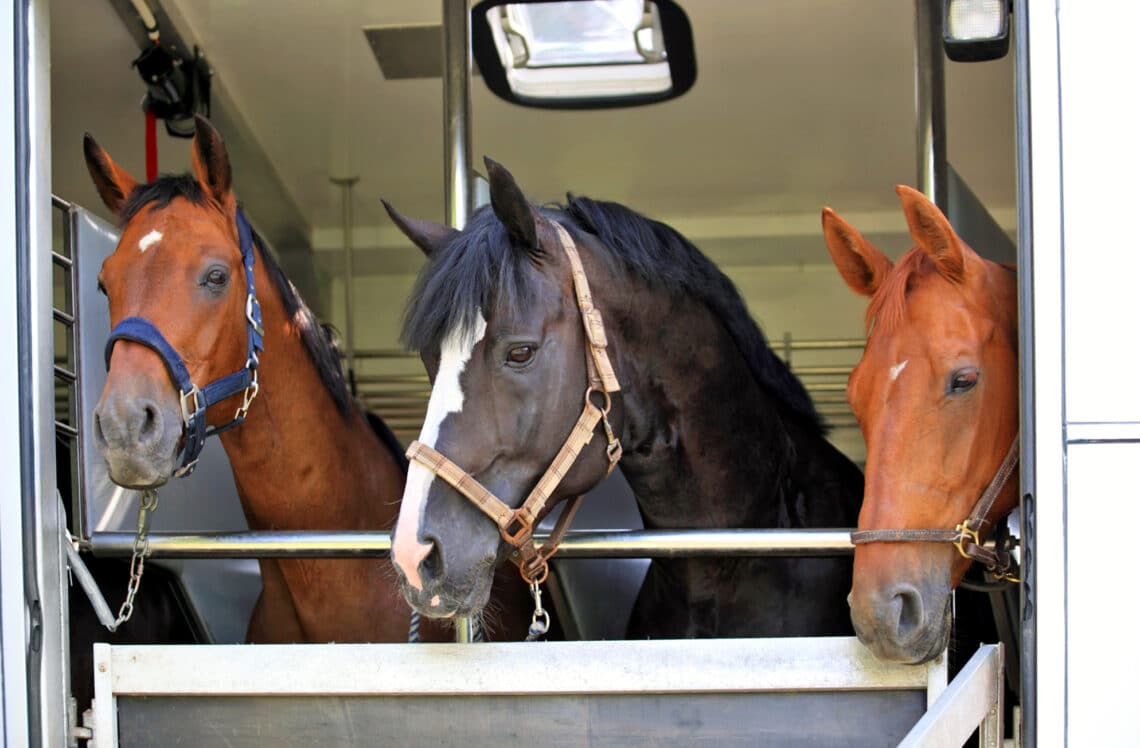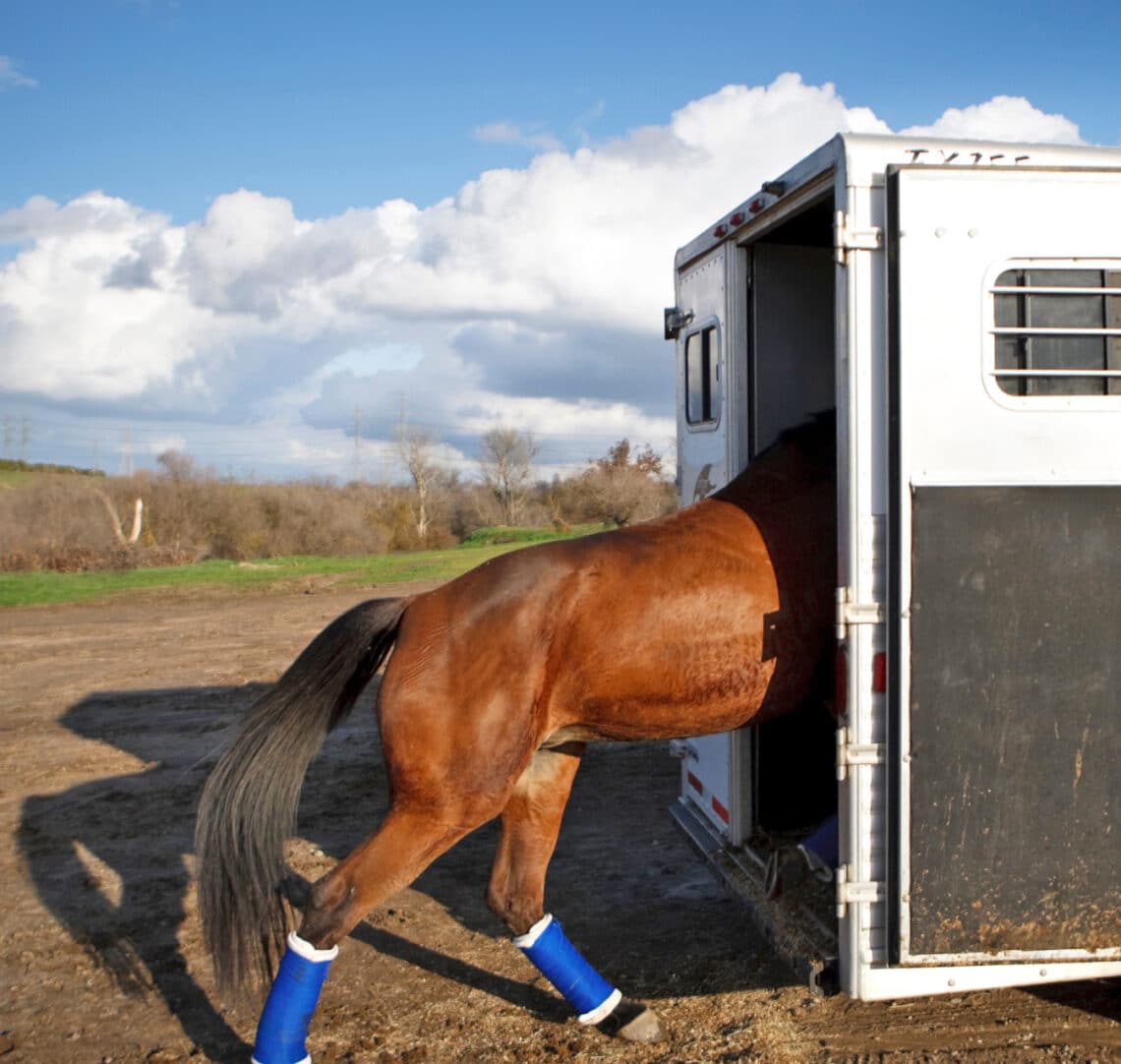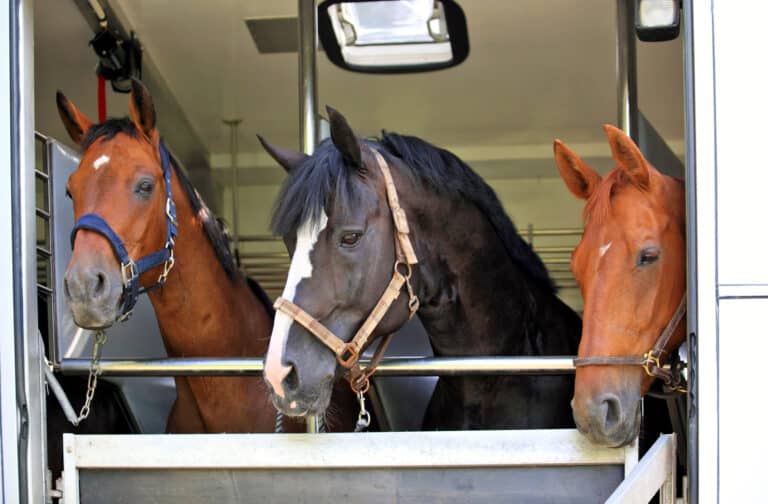
Have horse, will travel
Knowledge and planning can help reduce travel stressors for your horse, writes DR JENNIFER STEWART.
The worries of transporting our horses can often take much of the fun out of leaving home for a day out riding with friends or going to a competition. Understanding what’s going on inside the float during travel plus a little planning can make a difference to the amount of stress our equine companions experience.
Transport stress for horses can be caused by a combination of factors, including unfamiliar companions; isolation; movement beneath their feet; acceleration and deceleration; upward and downwards slopes; breaking, noise and vibrations; natural and chemical contaminants; disruptions to feeding and drinking routines; and fluctuations in temperature, humidity and light. The amount and level of stress an individual horse experiences is linked to their temperament and previous travel experiences, their orientation during travel, ability to move their heads, driver skill, ventilation and window placement.
Ventilation and temperature: Good ventilation is vital for air temperature, humidity and levels of bacteria, dust and noxious gases such as ammonia and carbon dioxide/monoxide. Most trucks and floats are under-ventilated at all speeds (from 13 to 90km/h) and the confined space inside the float is not the healthiest environment.
Air entering the float/truck through windows and vents flows down towards the floor, where it becomes contaminated with dust from the bedding, noxious gases, manure and any bacteria. In floats, exhaust from the towing vehicle can further contribute to poor air quality, especially on shorter journeys and in heavier traffic. Noxious gases damage the cells lining the airways, reducing the efficiency of respiratory clearance and increasing the risk of respiratory infections – the most serious of which is ‘shipping fever’, ‘travel sickness’ or pneumonia.
Pathogens and their toxins (endotoxins) from dried manure may overwhelm a respiratory system weakened by trailer stress and can inflame the airways. Studies show that stabled horses are exposed to eight-fold higher concentrations of endotoxin than pastured horses and although there are no reports of endotoxin levels in transportation vehicles, we must assume they are elevated.
The trailer should be cleaned out before and after every trip and during rest stops. Vinegar, zeolite or baking soda can eliminate odours, neutralise some gases and disinfect hard surfaces. The most effective cleaning process involves scrubbing, cleaning with hot water and disinfecting with triple the concentration of disinfectant.
Heat stress: This can occur when the temperature in the float/truck is outside the horse’s comfort zone, the thermoneutral zone (TYNZ) where neither sweating nor shivering are required. Healthy horses have a wide TNZ (from 0 to 25°C). Their main means of losing heat is through evaporation from the skin and the respiratory tract. Inside-to-outside temperatures decrease with increasing speed and when vents and windows are open, but are still generally 5–10°C higher than outside air temperature. High air temperatures coupled with high humidity and travel rugs impair sweating, and, if they become excessive, may cause the horse to experience heat stress.
Heat stress is greatest when the vehicle is stationary and when more than one horse is aboard, so park the vehicle in shaded areas with all windows and ramps open during rest stops.
Rugging your horse because you want to keep them ‘cosy’ while travelling can do far more harm than good if they get overheated. Overheating causes them to sweat, losing valuable water and electrolytes. Travelling does take quite a lot of physical effort for a horse so they can get very hot quite easily, making travel very uncomfortable.
Head position: Having horses tied so they can readily raise and lower their heads is one of the most important factors in reducing transport stress. When a horse’s head is elevated for long periods, normal airway clearance is compromised. Horses secrete respiratory mucosal discharges from the nose and if for whatever reason they can’t lower their head to expel this discharge it can drain backwards down the trachea and into their lungs. This, combined with factors including the stress of travel, increased temperature and dust can cause travel sickness. However, if they can lower their head below the point of their shoulders, they’re less likely to suffer respiratory stress. Cross-tying is associated with increased signs of stress.
Most hay nets are placed at the level of the horses’ nostrils to allow feeding and to keep the horse entertained. But, even clean, good quality hay contains dust particles and small mould spores that can be inhaled. Dampening the hay and placing it nearer the trailer floor, or replacing hay with pellets, reduces the risk of air contamination. To safeguard the respiratory system, choose a good bedding material which is not dusty, but very absorbent.
Direction of travel: The effects of transporting horses facing forwards, backwards or angled have been studied, and it’s been suggested that the orientation of the horse within the vehicle, combined with the duration of the journey and the driver’s technique, can contribute to the level of stress experienced.

When free-standing in an angled float/truck, no preference was shown for the angling to be either forward or backward. However, some horses develop slight muscle fatigue when travelling in the angled position.
Horses showing more stress-related and balance-related behaviours during transit had higher rectal temperatures and heart rates after arrival, both of which are correlated with a higher risk of stomach ulcer development.
Hydration/dehydration: Whether the horse wears bandages and the direction the horse faces during travel are all personal preferences. A non-negotiable is access to water and being able to rest for a minimum of 30 minutes every 4-6 hours. During this downtime, horses should be unloaded, allowed to graze or fed hay with their head down, and checked for signs of stress, overheating and gastric discomfort. Increasing salt intake for a few days before travel and using early cut hay and beet pulp all increase the water-holding capacity of the gut. Beet pulp, psyllium and soymeal are also all excellent prebiotics.
Even when water is available, horses tend to dehydrate during a journey and many don’t drink when travelling, even when water is freely available. Administering an electrolyte is good practice. You can make a good electrolyte supplement with straight salt, or a 3:1 ratio of straight salt: lite or lo-salt. For horses who are fussy about anything added to their feed, try this cookie recipe: 2 cups of grain, 2 cups of rolled oats, 24 ounces of electrolyte mix (commercial or homemade), 3 cups bran, 1 to 2 cups of water, and 1 cup of molasses, maple syrup, or apple sauce to sweeten. Mix well and divide into 24 cookies. Cook at 175°C for 25 to 30 minutes. Each cookie has around 25g of electrolytes.
There are several techniques often implemented to minimise the risk and extent of dehydration. One involves the familiarisation of horses with an aqueous normalising substance, such as apple flavouring, which reportedly offsets any difference in water taste during transportation and at the destination. Feeding soaked hay and dampening hard feed can also increase water intake. Adding salt to drinking water should be done sensibly and with great care. Do not exceed 30g of salt per 5 litres of water and always provide separate plain water. Water intake for a 500kg horse is 25-30 litres a day. When rehydrating they may drink upwards of 50 litres a day. Monitoring water intake and manure consistency before, during and after travel allows you to act pre-emptively.
Dehydration can also cascade into more serious metabolic situations such as laminitis and impaction colic. If you are concerned, call your vet immediately. Transportation stress combined with changes in diet and the environment also increase the likelihood diarrhoea and Salmonella. If horses travel alone, hanging a mirror in the float has been shown to reduce the time spent turning their head, vocalising and head-tossing, while eating behaviour increased.

Teaching your horse to load and unload calmly; monitoring heart rate and temperature before, during and after travel; knowing what’s normal for your horse (manure, water intake); and reducing as many stressors as possible increase the chances of safe travel – as does careful driving.
Reactivity, anxiety and restlessness are not uncommon in horses, especially when travelling. Temperament and tractability studies in horses of all ages show they are calmer and more inquisitive on oil-enriched, low starch/sugar feeds, and with correct magnesium supplementation. Combinations of magnesium plus tryptophan are contraindicated as current research shows tryptophan can cause stimulation and excitement 2 to 4 hours after dosing; does not change reactive behaviour; and that long-term use may have detrimental effects.
For more information, this study provides a fascinating read and lots of useful tips. Dr Jennifer Stewart BVSc BSc PhD is an equine veterinarian, CEO of Jenquine and a consultant nutritionist in Equine Clinical Nutrition.
All content provided in this article is for general use and information only and does not constitute advice or a veterinary opinion. It is not intended as specific medical advice or opinion and should not be relied on in place of consultation with your equine veterinarian.
| Table 1. Amount of time on Behaviour and body posture facing forwards or backwards | ||
| Facing forwards | Facing backwards | |
| Whinnying | 64% | 26% |
| Shifting position | 37% | 3% |
| Rump-resting | 26% | 64% |
| Head and neck up | 90% | 60% |
| Head and neck down | 1% | 37% |



